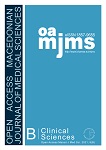Prevalence of Sleep Disorders in Adolescents and its Relation with Screen Time during the COVID-19 Pandemic Era
DOI:
https://doi.org/10.3889/oamjms.2021.5974Keywords:
Prevalence, Sleep disorder, Screen time, Adolescent, COVID-19Abstract
BACKGROUND: Sleep disorders encompass disturbances in the amount, quality, or timing of sleep. Several factors have contributed to sleep disorders in adolescents, including the use of electronic devices. In the COVID-19 pandemic era, there is a rising trend of screen time.
AIM: The objective of the study was to identify the prevalence of sleep disorders in adolescents and its relation with screen time during the COVID-19 pandemic era.
METHODS: This is a cross-sectional study involving students aged 15–18 years at three State High School, Denpasar, and Santo Yoseph Senior High School, Denpasar, in August 2020, using purposive sampling method. Data collections on characteristics of the subjects and Pittsburgh Sleep Quality Index (PSQI) were performed using Google Forms. Statistical analysis was performed using Chi-square test.
RESULTS: A total of 243 students participated in this study, of which 39 students were excluded due to chronic diseases and consumption of caffeine within 6 h before bedtime. Sleep disorder was found in 30.4% of subjects and mostly characterized by sleep duration of <8 h (62.9%). Analysis of the association between screen time and sleep disorders showed a significant result (PR = 3.8, 95%CI = 1.09–13.1, p = 0.02).
CONCLUSION: The prevalence of sleep disorders in adolescents is considerably high. There is an association between screen time and sleep disorders that occur in adolescents during the COVID-19 pandemic era.Downloads
Metrics
Plum Analytics Artifact Widget Block
References
Kumar VM. Sleep and sleep disorders. Indian J Chest Dis Allied Sci. 2008;50(1):129-35. PMid:18610697
Paruthi S, Brooks LJ, D’Ambrosio C, Hall WA, Kotagal S, Lloyd RM, et al. Recommended amount of sleep for pediatric populations: A consensus statement of the American academy of sleep medicine. J Clin Sleep Med. 2016;12(6):785-6. https://doi.org/10.5664/jcsm.5866 PMid:27250809 DOI: https://doi.org/10.5664/jcsm.5866
Lund HG, Reider BD, Whiting AB, Prichard JR. Sleep patterns and predictors of disturbed sleep in a large population of college students. J Adolesc Health. 2010;46(2):124-32. https://doi.org/10.1016/j.jadohealth.2009.06.016 PMid:20113918 DOI: https://doi.org/10.1016/j.jadohealth.2009.06.016
Urner M, Tornic J, Bloch KE. Sleep patterns in high school and university students: A longitudinal study. Chronobiol Int. 2009;26(6):1222-34. https://doi.org/10.1080/07420520903244600 PMid:19731114 DOI: https://doi.org/10.1080/07420520903244600
National Sleep Foundation. 2006 Teens and Sleep. Washington, DC: National Sleep Foundation; 2006. Available from: https:// www.sleepfoundation.org. [Last accessed on 2020 May 18].
Chokroverty S. Overview of sleep and sleep disorders. Indian J Med Res. 2010;131:126-40. https://doi.org/10.1542/peds.2014-1696 PMid:20308738
Owens J, Adolescent Sleep Working Group, Committee on Adolescence. Insufficient sleep in adolescents and young adults: An update on causes and consequences. Pediatrics. 2014;134(3):e921-32. DOI: https://doi.org/10.1542/peds.2014-1696
Drake C, Roehrs T, Shambroom J, Roth T. Caffeine effects on sleep taken 0, 3, or 6 hours before going to bed. J Clin Sleep Med. 2013;9(11):1195-200. https://doi.org/10.5664/jcsm.3170 PMid:24235903 DOI: https://doi.org/10.5664/jcsm.3170
Yland J, Guan S, Emanuele E, Hale L. Interactive vs passive screen time and nighttime sleep duration among school-aged children. Sleep Health. 2015;1(3):191-6. https://doi.org/10.1016/j.sleh.2015.06.007 PMid:27540566 DOI: https://doi.org/10.1016/j.sleh.2015.06.007
Ikatan Dokter Anak Indonesia. Rekomendasi IDAI Selama Anak Menjalani Sekolah Dari Rumah; 2020. Available from: https:// www.idai.or.id. [Last accessed on 2020 Aug 02].
Kenney EL, Gortmaker SL. United States adolescents’ television, computer, videogame, smartphone, and tablet use: Associations with sugary drinks, sleep, physical activity, and obesity. J Pediatr. 2017;182:144-9. https://doi.org/10.1016/j.jpeds.2016.11.015 PMid:27988020 DOI: https://doi.org/10.1016/j.jpeds.2016.11.015
Cajochen C, Frey S, Anders D, Späti J, Bues M, Pross A, et al. Evening exposure to a light-emitting diodes (LED)-backlit computer screen affects circadian physiology and cognitive performance. J Appl Physiol (1985). 2011;110(5):1432-8. https://doi.org/10.1152/japplphysiol.00165.2011 PMid:21415172 DOI: https://doi.org/10.1152/japplphysiol.00165.2011
Asiyah SN, Putri AY. Relationship between Smartphone Addictions with Sleep Quality in Adolescents. Proceedings of the International Conference on Sustainable Health Promotion, 2018 October 9-11. Surabaya, Indonesia: Faculty of Psychology and Health, Sunan Ampel State Islamic University; 2018. p. 92-9.
Wiederhold BK. Children’s screen time during the COVID-19 pandemic: Boundaries and etiquette. Cyberpsychol Behav Soc Netw. 2020;23(6):359-60. https://doi.org/10.1089/cyber.2020.29185.bkw PMid:32437623 DOI: https://doi.org/10.1089/cyber.2020.29185.bkw
Eyimaya AO, Irmak AY. Relationship between parenting practices and children’s screen time during the COVID-19 pandemic in Turkey. J Pediatr Nurs. 2021;56:24-9. https://doi.org/10.1016/j.pedn.2020.10.002 PMid:33181369 DOI: https://doi.org/10.1016/j.pedn.2020.10.002
Buysse DJ, Hall ML, Strollo PJ, Kamarck TW, Owens J, Lee L, et al. Relationships between the pittsburgh sleep quality index (PSQI), epworth sleepiness scale (ESS), and clinical/polysomnographic measures in a community sample. J Clin Sleep Med. 2008;4(6):563-71. https://doi.org/10.5664/jcsm.27351 PMid:19110886 DOI: https://doi.org/10.5664/jcsm.27351
Setyowati A, Chung M. Validity and reliability of the Indonesian version of the pittsburgh sleep quality index in adolescents. Int J Nurs Pract. 2020;e12856. https://doi.org/10.1111/ijn.12856 PMid:32632973 DOI: https://doi.org/10.1111/ijn.12856
Ohida T, Osaki Y, Doi Y, Tanihata T, Minowa M, Suzuki K, et al. An epidemiologic study of self-reported sleep problems among Japanese adolescents. Sleep. 2004;27(5):978-85. https://doi.org/10.1093/sleep/27.5.978 PMid:15453558 DOI: https://doi.org/10.1093/sleep/27.5.978
LeBourgeois MK, Hale L, Chang AM, Akacem LD, Montgomery- Downs HE, Buxton OM. Digital media and sleep in childhood and adolescence. Pediatrics. 2017;140 Suppl 2:S92-6. https://doi.org/10.1542/peds.2016-1758j PMid:29093040 DOI: https://doi.org/10.1542/peds.2016-1758J
Shochat T, Flint-Bretler O, Tzischinsky O. Sleep patterns, electronic media exposure and daytime sleep-related behaviours among Israeli adolescents. Acta Paediatr. 2010;99(9):1396-400. https://doi.org/10.1111/j.1651-2227.2010.01821.x PMid:20377536 DOI: https://doi.org/10.1111/j.1651-2227.2010.01821.x
Khalsa SB, Jewett ME, Cajochen C, Czeisler CA. A phase response curve to single bright light pulses in human subjects. J Physiol. 2003;549(3):945-52. https://doi.org/10.1113/jphysiol.2003.040477 PMid:12717008 DOI: https://doi.org/10.1113/jphysiol.2003.040477
Cajochen C, Chellappa SL, Schmidt C. Circadian and light effects on human sleepiness-alertness. In: Garbarino S, Nobili L, Costa G, editor. Sleepiness and Human Impact Assessment. Milan: Springer; 2014. p. 9-22. https://doi.org/10.1007/978-88-470-5388-5_2 DOI: https://doi.org/10.1007/978-88-470-5388-5_2
Brainard GC, Hanifin JP, Greeson JM, Byrne B, Glickman G, Gerner E, et al. Action spectrum for melatonin regulation in humans: Evidence for a novel circadian photoreceptor. J Neurosci. 2001;21(16):6405-12. https://doi.org/10.1523/jneurosci.21-16-06405.2001 PMid:11487664 DOI: https://doi.org/10.1523/JNEUROSCI.21-16-06405.2001
Chang AM, Aeschbach D, Duffy JF, Czeisler CA. Evening use of light-emitting eReaders negatively affects sleep, circadian timing, and next-morning alertness. Proc Natl Acad Sci USA. 2015;112(4):1232-7. https://doi.org/10.1073/pnas.1418490112 PMid:25535358 DOI: https://doi.org/10.1073/pnas.1418490112
Downloads
Published
How to Cite
Issue
Section
Categories
License
Copyright (c) 2020 I Gusti Ayu Trisna Windiani, Ni Made Reditya Noviyani, I. Gusti Agung Ngurah Sugitha Adnyana, Ni Luh Sukma Pratiwi Murti, Soetjiningsih Soetjiningsih (Author)

This work is licensed under a Creative Commons Attribution-NonCommercial 4.0 International License.
http://creativecommons.org/licenses/by-nc/4.0







